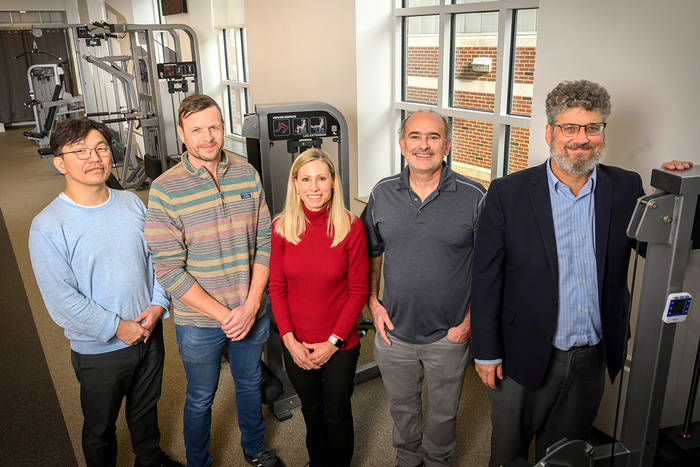Exercise looks a little different en route to the Red Planet, so Professor Marni Boppart got creative.

Credit: Fred Zwicky
Exercise looks a little different en route to the Red Planet, so Professor Marni Boppart got creative.
Boppart and her colleagues at the Beckman Institute for Advanced Science and Technology received $1 million from the Translational Research Institute for Space Health, a NASA-funded institute, to explore the regenerative power of cells in space. Their research will help protect human health aboard Orion, the spacecraft destined to ferry astronauts from the Earth to the moon and Mars.
Because of the Earth’s mass, our daily movement is generally sufficient to keep our muscles in fine working order. Astronauts soaring through space are not afforded the luxury of gravitational pull.
“Astronauts can lose up to 20% of muscle mass after just two weeks, and 1-2% of bone mineral density every month. The longer the space travel, the greater the deterioration of tissues and physiological systems in the human body,” said Boppart, a professor of kinesiology and community health studying the science of exercise at the University of Illinois Urbana-Champaign.
Before joining the university, Boppart specialized in high-altitude health hazards as an officer and aerospace physiologist in the U.S. Air Force. Her current research in the College of Applied Health Sciences focuses on the molecular underpinning of muscle loss and gain. She hopes to develop cell-inspired strategies for recovering strength in circumstances — like spaceflight — when movement and mobility are limited.
When TRISH invited researchers to explore new ways to protect astronaut health and performance by enhancing the human body’s own maintenance and cellular repair abilities, Boppart seized the opportunity. Her project reimagines interstellar fitness with a cellular flair. The institute was scouting for strategies to protect astronaut health during long-duration space exploration missions, including NASA’s ongoing Artemis program, which will set up a sustainable presence on the Moon and prepare for future missions to Mars.
The Artemis program’s chosen vessel is the spacecraft Orion, which launched unmanned from the Kennedy Space Center in November. At the top of the vessel’s formidable to-do list is ferrying the first woman and first person of color from the Earth to the moon, followed closely by establishing humanity’s first long-term lunar presence and eventually trekking to the Red Planet.
Square footage is limited on Orion, which assumes the trifold identities of dormitory, dining hall, and control room all in one. The spacecraft is understandably bereft of the specialized resistance and endurance equipment that astronauts have access to on the International Space Station.
“But even the most intense [exercise] protocols performed in space are not sufficient to overcome the negative impacts of microgravity,” said Boppart. “Alternatives to traditional exercise, ideally based on exercise principles, are required.”
With an approach fit for space travel, Boppart’s proposal turns our traditional understanding of exercise on its head — or rather, inside out. Instead of defining exercise by heavy footfalls or flailing limbs, she’s focusing squarely on the cellular relay underway within our muscles.
Honed by relentless evolution, our cells have yet to catch on to the concept of exercising for fun. When we lift heavy weights or engage in rigorous activities, our cells react with a well-intentioned stress response, deploying a battalion of chemicals into the bloodstream to boost our body’s ability to survive future threats. If a weight that once seemed too heavy becomes manageable with time and training, you have your overprotective, stressed-out cells to thank.
These chemical payloads don’t navigate the bloodstream’s harsh terrain on their own. Some are wrapped in a protective lipid layer called an extracellular vesicle, named for its pickup and delivery routes that transfer restorative chemicals from cell to cell.
Boppart believes that the extracellular vesicles our bodies generate after exercising, and the chemicals they contain, can trigger the restorative effects of exercise — even when no exercise has taken place.
“When we exercise, it’s not only our muscles that benefit, but all tissues, including the brain and skin. Our TRISH-sponsored work will directly test the ability of extracellular vesicles released after exercise to protect human health in space,” Boppart said.
The broad aim of Boppart’s study is to use extracellular vesicles generated naturally by volunteers on Earth, or even artificially, to replicate the restorative effect of exercise in astronauts, essentially enabling their muscles to engage in post-exercise recovery without ever having to lift a space-suited finger.
“Astronauts are the target population for this funded study, but the result could potentially be used to prevent, maintain, or treat a variety of conditions associated with inactivity and disuse, including aging, disability, or even disease, which would be exceptionally fulfilling,” Boppart said.
Her interdisciplinary collaborators at the Beckman Institute include: Justin Rhodes, a professor of psychology; Taher Saif, a professor of mechanical science and engineering; Jonathan Sweedler, a professor of chemistry; and Hyunjoon Kong, a professor of chemical and biomolecular engineering. UIUC professor of kinesiology and community health Nicholas Burd is also a co-investigator.
Research for the project titled “Design of an extracellular vesicle approach to protect human health in space” is expected to begin in October 2023. The $1 million award will be dispersed over two years. This study is funded by the Translational Research Institute for Space Health at Baylor College of Medicine. TRISH is funded by the NASA Human Research Program. The award was administered through the TRISH Biomedical Research Advances for Space Health solicitation.
About Beckman: The Beckman Institute for Advanced Science and Technology is an interdisciplinary research institute located on the University of Illinois Urbana-Champaign campus. Founded in 1989 by philanthropist and inventor Arnold O. Beckman, the institute supports research across disciplines among University of Illinois faculty members to foster scientific advances that would not be possible elsewhere. Researchers at the Beckman Institute develop imaging tools, study the origins of intelligence, and harness molecules to create better drugs and materials.
Media contact: Jenna Kurtzweil at [email protected]




